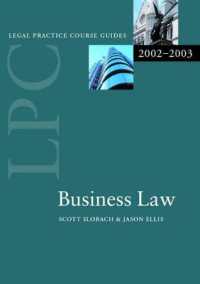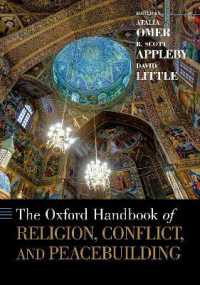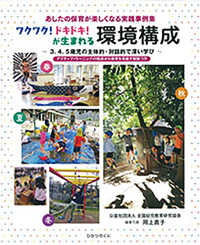- ホーム
- > 洋書
- > 英文書
- > History / World
Full Description
A multidisciplinary study of African pastsphilosophy come together in one place.African Histories gives readers a rich understanding of Africa's complex history through a wide variety of sources while exposing them to the African voice. The text offers examples of how scholars have, over the past 60 years, demonstrated Africa's detailed history. It is about how historians interpret the past by giving full and adequate attention to the stories of Africans in ways that can be meaningful and acceptable to Africans and researchers alike. The text is titled African Histories in recognition of the diversity of sources and ways in which they are examined.
Contents
PrefaceChapter 1: Archaeobotany and Cultivation in Africa CHAPTER OBJECTIVESTHE PROBLEMHumans and plant interactionSource 1.1: Cave painting of hunters and their prey, southern Africa, undatedSource 1.2: Conversations with Ogotemmeli, Dogon-speaker, Sahelian West Africa, 1965Source 1.3: The Eloquent Peasant, Middle Kingdom Egypt/Kemet (c.2040-1650 BCE)THE METHODSource 1.4: Pollen from important Sahelian crops, 1995-2005Source 1.5: Enset and banana phytoliths, 2005-2006THE EVIDENCEThe spread and use of Bananas in AfricaSource 1.6: Comparative morphology of Musa and Ensete phytoliths, 2005-2006Wine and Beer in Pharaonic and Roman EgyptSource 1.7: Main components of pollen samples from Saruma amphorae (jars), 4th-7th century CEEXERCISESExercise 1: Exploring the domestication of sorghumExercise 2: Interpreting archaeobotanical dataFURTHER READINGChapter 2: Early Written Evidence of State and Society in Classical North-Eastern AfricaCHAPTER OBJECTIVESTHE PROBLEMThe Scorpion King and depictions of ancient and classical North-East AfricaHow did early North-East African societies organize themselves to face challenges?Writing in North-East AfricaThe connections between written sources and challenges to societyTHE METHODBasic practices for interpreting sourcesTHE EVIDENCEEgypt: The Book of the Dead and the challenge of creating a civil societySource 2.1: Two versions of the "Declaration of Innocence", Late Period Egypt, c.717-332 BCEKush: The Confirmation of Aspelta and the challenge of successionSources 2.2: Aspelta's Coronation stela, image and translation, Napata, c.600-595 BCEAksum: Ezana's conquest stones and the challenge of warSource 2.3: Ezana's conquest stone, Meroe (c.360-350 CE)EXERCISES Exercise 1: Interpreting early written sourcesExercise 2: Reflections upon the meaning of written sourcesFURTHER READINGChapter 3: Linguistic Evidence and the Bantu ExpansionCHAPTER OBJECTIVESTHE PROBLEM The Bantu expansion THE METHODLanguage classification and linguistic methods Source 3.1: Tree diagram for Great Lakes Bantu, present day extending backwardSource 3.2: Tree diagram for Western Lakes (a portion of Great Lakes Bantu)Word histories and social histories: How social historians use linguistic evidenceTHE EVIDENCE Western Lakes Bantu as a case studySource 3.3: Western Lakes terms for discussing power, c.200-1400Source 3.4: Constructing Dominion over the Land, c.200-1400EXERCISES Exercise 1: Interpreting linguistic evidence of Nilo-Saharan languagesSource 3. 5: A section of the Nilo-Saharan language group (not all modern or historical languages shown)Source 3.6: Words from the Nilo-Saharan family, c.1 CE - PresentFURTHER READINGChapter 4: Archaeological Evidence for the Development of African CitiesCHAPTER OBJECTIVESTHE PROBLEM Early African CitiesTHE METHOD The practice of archaeology in AfricaSource 4.1: Sequence Chart for Northern Upemba Depression"Historians, are Archaeologists your Siblings?": Using archaeological evidence and evaluating archaeological studiesTHE EVIDENCE The Middle Niger as a case studySource 4.2: Discovery/Recovery, 1977Sources 4.3 and 4.4: The FindingsSources 4.5 and 4.6: InterpretationsEXERCISES Exercise 1: decoding a text on Benin City (in modern Nigeria)Exercise 2: stratigraphy and association in Benin City Source 4.7: Stratigraphic analysis of Clerks' Quarters site, Benin, 1975Exercise 3: analysis of Northern Upemba Depression (in modern Democratic Republic of Congo)Exercise 4: Interpreting archaeological dataFURTHER READINGSChapter 5: African Memories and Perspectives of the Atlantic Slave TradeCHAPTER OBJECTIVESTHE PROBLEM How did West and Central Africans understand and experience the Atlantic Slave Trade?THE METHODSOral HistoriesSource 5.1: Sibell's Narrative, collected by John Ford, Barbados, 1799Autobiographies and memoiresSource 5.2: The autobiography of Venture Smith, Connecticut, 1798Oral TraditionSource 5.3: "Kpele" dirge memorializing the effects of the Atlantic Slave Trade, Ghana, collected c.1970THE EVIDENCE Olaudah Equiano's Interesting Narrative as a memory of Africa during the era of the Atlantic slave tradeSource 5.4: Olaudah Equaino's memories of Essaka, written in London, c.1789Written and oral accounts of "cannibalism" and "witchcraft" as idioms for understanding the slave tradeSource 5.5: The slave trade viewed through the idiom of cannibalism, 1659-1755Oral traditions from Atorkor as a message from the pastSource 5.7: Togbui Awusa's narrative, Ghana, collected c.2002EXCERCISES Exercise 1: Interpreting memory in oral and written formExercise 2: Ashy's narrative from BarbadosSource 5.8: Ashy's Narrative ('Fantee'), transcribed by John Ford, Barbados, 1799FURTHER READINGSChapter 6: Islamic Sources and Version of Swahili OriginsCHAPTER OBJECTIVESTHE PROBLEM "Origins" in African history and the Swahili pastTHE METHOD Islamic sources in AfricaThe production of sources as a guide to their meaningTHE SOURCE The Pate Chronicle Source 6.1: Excerpt from the Stigand Version of the Pate Chronicles, 1908, Lamu archipelagoSource 6.2: Excerpt from the Werner version of the Pate Chronicles, 1911, Lamu archipelagoSource 6.3: King-list of Pate from the Werner version of the Pate ChroniclesSource 6.4: MS 177 version of the Pate Chronicles, c.1900, Lamu archipelago/Dar es SalaamSource 6.5: Tomalcheva's "stratigraphy" of versions of the Pate ChronicleSource 6.6: Pouwels' comparisons of king-lists in versions of the Pate ChroniclesEXERCISES Exercise 1: Exploring Swahili originsExercise 2: interpreting versions of thePate ChronicleFURTHER READINGChapter 7: Intellectual History and Cultural Nationalism in West AfricaCHAPTER OBJECTIVESTHE PROBLEM Who were nineteenth century West African intellectuals and how can we describe their projects?THE METHOD Intellectual history through written sourcesTHE SOURCES The emergence of West African cultural nationalistsJames Africanus Horton on self-government in West AfricaSource 7.1: James Africanus Horton, West African Countries and Peoples, completed in the United Kingdom, 1868John Mensah Sarbah on indigenous institutions of governmentSource 5.2: John Mensah Sarbah, Fanti National Constitution, Ghana, 1906EXERCISES Exercise 1: analyzing Casely-Hayford's Gold Coast Native InstitutionsSource 5.3: J.E. Casely-Hayford, Gold Coast Native Institutions, Written in West Africa and published in the United Kingdom, 1903Exercise 2: Cultural nationalism as a theme in intellectual historiesFURTHER READINGChapter 8: Planning, Photography, and the Struggle for Power in Colonial AfricaCHAPTER OBJECTIVESTHE PROBLEMWhat was everyday life like for Africans under colonial rule?THE METHOD"Power" as a concept in human societiesArchitecture and urban planning as evidence of power relationshipsSource 8.1: Italian plan for colonial Addis Ababa, Ethiopia, 1940Source 8.2: Photograph of Atakpame, Togoland, c.1910Source 8.3: European buildings in Palime, Togoland, c.1910Source 8.4: Women's March on the Union Buildings, Pretoria, South Africa, August 9, 1956Photographs as evidence of power relationshipsSource 8.5: Hair dressing in Abokobi, Gold Coast (modern Ghana), c.1900-1904Source 8.6: "Is It Higher Wages at Last?", South Africa, 1960THE EVIDENCEArchitecture and urban planning in Italian colonial North and North-East AfricaSource 8.7: Arch by Rava in Somalia, 1935Two neighboring "national" monuments in South Africa: The Voortrekker Monument and Freedom ParkSource 8.8: The Voortrekker Monument, South Africa, completed 1949Source 8.9: Images from the "historical frieze", Voortrekker MonumentSource 8.10: Freedom Park and Voortrekker Monument, Pretoria, 2009EXERCISESExercise 1: Interpreting the built environmentExercise 2: City planning and architecture in Cape TownSource 8.11: "District Six: The Razzle and Dazzle Good, Bad Land", Cape Town, 1963Source 8.12: District six before and after forced removals, Cape TownSource 8.13: The Rhodes Memorial, Cape Town, 2009FURTHER READINGChapter 9: Remembering Decolonization Through Ethnography and Popular Painting in Central AfricaCHAPTER OBJECTIVESTHE PROBLEMHow can we comprehend popular experiences of decolonization in Africa?THE METHODThe challenge of understanding art as an historical sourceEthnographyTHE SOURCESThe Congo CrisisMemory and Popular Paintings of the Congo CrisisSources 9.1 and 9.2: Two popular paintings from Democratic Republic of Congo, 1990sEthnographies of popular paintersSources 9.3 and 9.4: Tshibumba Kanda Matulu (T) and Johannes Fabian (F) Democratic Republic of Congo, 1990s (representing 1960)Source 9.5: Tshibumba Kanda Matulu paintings, Democratic Republic of Congo, 1990s (representing 1960)Sources 9.6 and 9.7: Tshibumba Kanda Matulu paintings, Democratic Republic of Congo, 1990s (representing 1960/1961)EXERCISESExercise 1: Interpretation of ethnographySource 9.8: Tshibumba Kanda Matulu, "The Deaths of Lumumba, Mpolo and OkitoExercise 2: Representations of LumumbaSources 9.9 and 9.10, Tshibumba Kanda Matulu paintings, Democratic Republic of Congo, 1990s (representing 1960)Source 9.11: Interview between Fabian (F) and Tshibumba (T), Democratic Republic of Congo, 1990sFURTHER READINGSChapter 10 : Literature and Decolonization in AfricaCHAPTER OBJECTIVESTHE PROBLEM How did Africans perceive the causes, strategies, and effects of the struggle for independence?THE METHOD Historicizing literature as a product of societySource 10.1: Excerpt from Leopold Sedar Senghor, "Message", c.1945, France/SenegalSource 10.2: Excerpts from Kobina Sekyi's "The Anglo-Fanti", c.1917-1918, GhanaThe role of literature in the formation of culture and politicsTHE SOURCES Things Fall Apart: Chinua Achebe's precolonial Africa from the insideSource 10.3: Achebe on themes in Things Fall Apart, 1969-1981Source 10.4: Proverbs from Things Fall Apart, 1958, NigeriaSource 10.5: First stanza of William Butler Yeats' The Second Coming, 1920, IrelandGod's Bits of Wood: Sembene Ousmane's visions of the decolonization of SenegalSource 10.6: Excerpts from God's Bits of Wood, 1959-1960, SenegalSource 10.7: Excerpt from God's Bits of WoodSource 10.8: Gadjigo on reading God's Bits of Wood, 2007EXERCISESExercise 1: Interpreting novels by African authorsExercise 2: Analyzing David Diop's "The Time of the Martyr"Source 10.9: D. Diop, "The Time of the Martyr"FURTHER READINGChapter 11: Textbooks and Tribunals in the Aftermath of CrisesCHAPTER OBJECTIVESTHE PROBLEM How do societies and individuals deal with the aftermath of crises?THE METHOD Reading curricula and course materialsSource 11.1: Textbook treatments of the 1913 Native Land Act, 1974/1999, South AfricaSources 11.2: South African curriculum policy statements, 1962/2005, South AfricaReading TestimoniesSource 11.3: Testimony from the Special Court for Sierra Leone, 2006, Sierra Leone/NetherlandsTHE EVIDENCE The Truth and Reconciliation Commission in South AfricaSource 11.4: The purposes of the TRC, 1994/1998, South AfricaSource 11.5: Testimony of Sheila Thandiwe Bless, on the death of Zandisile Matiti, 1996, Queenstown, South AfricaSource 11.6: Questions at the Amnesty Hearings, 1997, Cape Town, South AfricaSource 11.7: Political groups submissions to the TRC, 1996, South AfricaRwandaSource 11. 8: The Gacaca Courts, 2001, RwandaSource 11.9: A Lesson plan for Module III of the proposed Rwandan history curriculum, 2006, RwandaEXERCISES Exercise 1: Intepreting courtroom testimonyFURTHER READINGSChapter 12: Anthropology and the Gendering of the Study of AIDS in AfricaCHAPTER OBJECTIVESTHE PROBLEMWhy has HIV/AIDS spread so fast and affected so many in Africa?THE METHODRelationships between anthropology and historyGender as a category of analysisTHE SOURCESStudies of gender, sexuality, and sex in Uganda and South AfricaSource 12.1: Theory in "African Sex is Dangerous!", Uganda, 2001-2003Source 12.2: Context in "African Sex is Dangerous!", Uganda, 2001-2003Source 12.3: Description in "African Sex is Dangerous!", Uganda, 2002-2003Source 12.4: Historical change in the meaning of isoka among isiZulu-speakers, South Africa, 1940sSource 12.5: Femininity among isiZulu-speakers, South Africa, 1920s and 1930sSource 12.6: Contemporary constructions of masculinity among isiZulu-speakers, South Africa, 2000sEXERCISESExercise 1: Interpreting ethnographic dataFURTHER READINGSEpilogue: African histories and Histories of AfricaThe Limitations of this bookMethods for exploring the pastThe values of historical enquiryQuestions remaining








